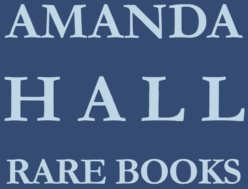- Tag = The Arts
-
 Anecdotes of Eminent Painters in Spain,
during the sixteenth and seventeenth centuries; with cursory remarks upon the present state of arts in that kingdom. By Richard Cumberland. In two volumes. Vol. I [-II].
London, J. Walter, 1782.
Anecdotes of Eminent Painters in Spain,
during the sixteenth and seventeenth centuries; with cursory remarks upon the present state of arts in that kingdom. By Richard Cumberland. In two volumes. Vol. I [-II].
London, J. Walter, 1782.
First Edition. Two volumes, 12mo (156 x 95 mm), pp. [iv], 225, [1], [2] index; [iv], 224, [1] index, [1], in contemporary tree calf, spines ruled in compartments and numbered in gilt, red morocco labels lettered in gilt.
ESTC t116936.
More details Price: £650.00 -
 Ideas for Rustic Furniture;
proper for Garden Seats, Summer Houses, Hermitages, Cottages, &c. on 25 plates.
London, I. & J. Taylor, the Architectural Library, circa 1800.
Ideas for Rustic Furniture;
proper for Garden Seats, Summer Houses, Hermitages, Cottages, &c. on 25 plates.
London, I. & J. Taylor, the Architectural Library, circa 1800.
First Edition. 8vo, (235 x 145 mm), 25 engraved plates including the title, some staining, particularly to the title-page, in slightly later marbled wrappers, sprung and detached, possibly the result of an early and not very successful restoration project, consequently several of the plates are loose.
ESTC t146494, at BL, RIBA, The National Trust, V & A and Massachusetts Institute of Technology only; the Met also has a copy.
More details Price: £2,000.00 -
![[The Four Elements.] Earth. Wind. Fire. Water. by HAMILTON, William RA (1751-1801), after.DALL' ACQUA, Giuseppe (1760-circa 1829), engraver.](https://images.vialibri.net/production/30/3227---200.jpg?v=1580471246) [The Four Elements.] Earth. Wind. Fire. Water.
Northern Italy, 1787.
[The Four Elements.] Earth. Wind. Fire. Water.
Northern Italy, 1787.
Four sheets, (362 x 260 mm), stipple-engraved prints, platemarks measuring 246 x 177 mm, the images presented in elegant slim ovals (198 x 98 mm), double ruled, each plate bearing an English title of one of the elements and signed ‘W. Hamilton delinet’ and ‘Giuseppe dall’ Acqua di Cristoforo scul. 1787’, the first print (Earth) also with ‘no. 343’, two pin-holes at the top of each sheet, with very light creasing and soiling but generally a very fresh, clean set with generous margins.
We have traced only one copy of these prints, a coloured and framed set appearing at auction in Rome, 28 October 2014. In addition to the V&A album cited above, the Huntington Library has another sketchbook of drawings by Hamilton.
More details Price: £3,200.00 -
 Traité théorique et pratique sur l’art de faire et d’appliquer les vernis;
sur les différens genres de peinture par impression et en décoration, ainsi que sur les couleurs simples et composées: accompagné de nouvelles observations sur le copal; de notes historiques sur la nature des matières et sur les procédés mis en usage par les compositeurs des couleurs et de vernis, et par les peintres vernisseurs et décorateurs, &c. &c. &c.
Geneva, Magnet, 1803.
Traité théorique et pratique sur l’art de faire et d’appliquer les vernis;
sur les différens genres de peinture par impression et en décoration, ainsi que sur les couleurs simples et composées: accompagné de nouvelles observations sur le copal; de notes historiques sur la nature des matières et sur les procédés mis en usage par les compositeurs des couleurs et de vernis, et par les peintres vernisseurs et décorateurs, &c. &c. &c.
Geneva, Magnet, 1803.
First Edition, Fine Paper Copy. Two volumes, 8vo, (198 x 124 mm), pp. [iv], xlviii, 326, [1] errata, [1] blank; [iv], 351, [1] errata, woodcut device on each title, with five etched plates (four folding) in vol. 1 and a folding printed table in vol. 2, printed on thick, blue tinted paper, in contemporary mottled calf, flat spines attractively gilt in compartments, with orange and black lettering pieces, a circular numbering piece in contrasting orange on the black label, lettered and numbered in gilt, with red sprinkled carmine edges, liberally applied leading to the partial closure of a couple of pages, a little rubbed at extremities but a handsome set, with the bookplate of the Bibliothèque de Mr. de Barante on the pastedowns.
Neville II, p. 558.
More details Price: £1,600.00

![Another image of [The Four Elements.] Earth. Wind. Fire. Water. by HAMILTON, William RA (1751-1801), after.DALL' ACQUA, Giuseppe (1760-circa 1829), engraver.](https://images.vialibri.net/production/30/3227_2---height_100.jpeg?v=1580471058)
![Another image of [The Four Elements.] Earth. Wind. Fire. Water. by HAMILTON, William RA (1751-1801), after.DALL' ACQUA, Giuseppe (1760-circa 1829), engraver.](https://images.vialibri.net/production/30/3227_2---height_100.jpg?v=1580470986)
![Another image of [The Four Elements.] Earth. Wind. Fire. Water. by HAMILTON, William RA (1751-1801), after.DALL' ACQUA, Giuseppe (1760-circa 1829), engraver.](https://images.vialibri.net/production/30/3227_4---height_100.jpg?v=1580472830)